transmission SAAB 9-5 2001 Owners Manual
[x] Cancel search | Manufacturer: SAAB, Model Year: 2001, Model line: 9-5, Model: SAAB 9-5 2001Pages: 272, PDF Size: 14.83 MB
Page 5 of 272
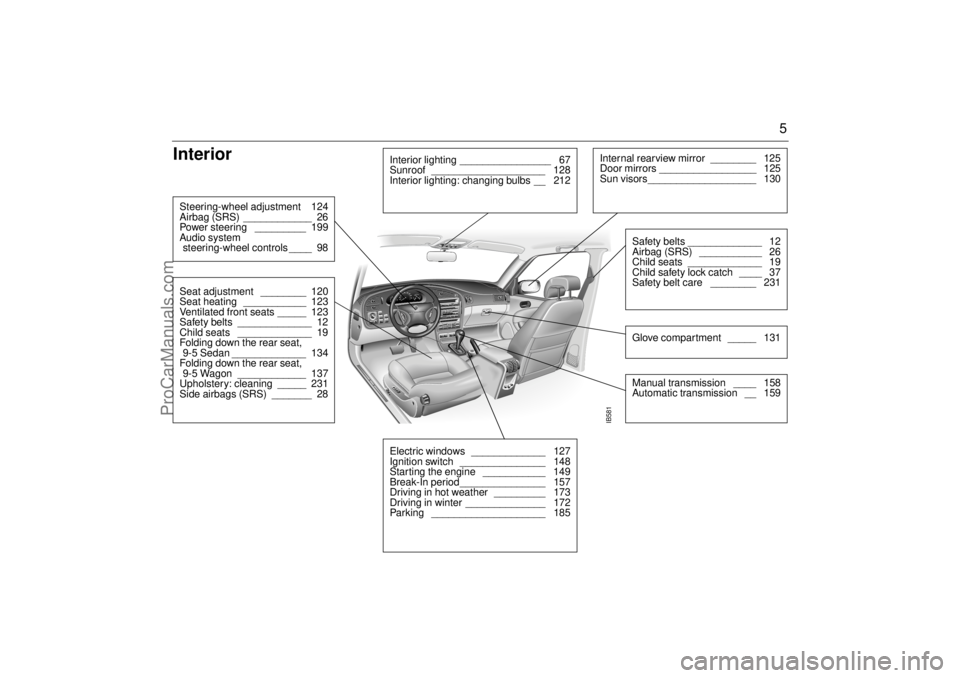
5
Interior
IB581Internal rearview mirror ________ 125
Door mirrors _________________ 125
Sun visors___________________ 130
Safety belts _____________ 12
Airbag (SRS) ___________ 26
Child seats _____________ 19
Child safety lock catch ____ 37
Safety belt care ________ 231Glove compartment _____ 131Manual transmission ____ 158
Automatic transmission __ 159
Electric windows _____________ 127
Ignition switch _______________ 148
Starting the engine ___________ 149
Break-In period_______________ 157
Driving in hot weather _________ 173
Driving in winter ______________ 172
Parking ____________________ 185
Steering-wheel adjustment 124
Airbag (SRS) ____________ 26
Power steering _________ 199
Audio system
steering-wheel controls ____ 98Seat adjustment ________ 120
Seat heating ___________ 123
Ventilated front seats _____ 123
Safety belts _____________ 12
Child seats _____________ 19
Folding down the rear seat,
9-5 Sedan _____________ 134
Folding down the rear seat,
9-5 Wagon ____________ 137
Upholstery: cleaning _____ 231
Side airbags (SRS) _______ 28
Interior lighting ________________ 67
Sunroof ____________________ 128
Interior lighting: changing bulbs __ 212
ProCarManuals.com
Page 6 of 272
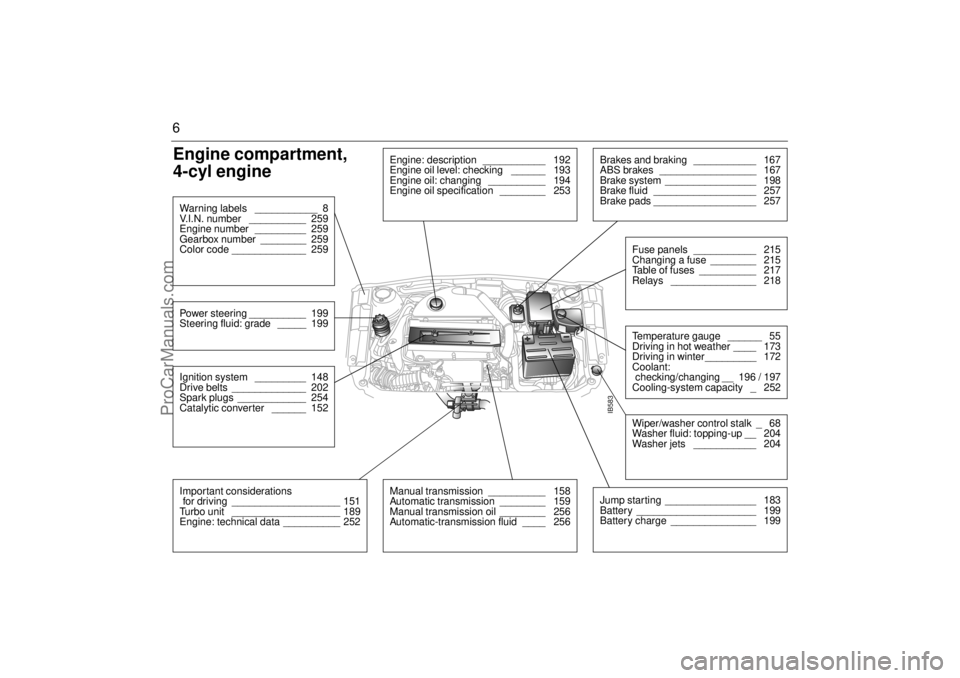
6Engine compartment,
4-cyl engine
IB583
Engine: description ___________ 192
Engine oil level: checking ______ 193
Engine oil: changing __________ 194
Engine oil specification ________ 253
Brakes and braking ___________ 167
ABS brakes _________________ 167
Brake system ________________ 198
Brake fluid __________________ 257
Brake pads __________________ 257
Fuse panels ___________ 215
Changing a fuse ________ 215
Table of fuses __________ 217
Relays _______________ 218Temperature gauge ______ 55
Driving in hot weather ____ 173
Driving in winter_________ 172
Coolant:
checking/changing __ 196 / 197
Cooling-system capacity _ 252
Power steering __________ 199
Steering fluid: grade _____ 199
Wiper/washer control stalk _ 68
Washer fluid: topping-up __ 204
Washer jets ___________ 204
Jump starting ________________ 183
Battery _____________________ 199
Battery charge _______________ 199
Manual transmission __________ 158
Automatic transmission ________ 159
Manual transmission oil ________ 256
Automatic-transmission fluid ____ 256
Important considerations
for driving ___________________ 151
Turbo unit ___________________ 189
Engine: technical data __________ 252Ignition system _________ 148
Drive belts _____________ 202
Spark plugs ____________ 254
Catalytic converter ______ 152Warning labels ___________ 8
V.I.N. number __________ 259
Engine number _________ 259
Gearbox number ________ 259
Color code _____________ 259
ProCarManuals.com
Page 7 of 272

7
Engine compartment,
3.0t V6
IB585
Warning labels ___________ 8
V.I.N. number __________ 259
Engine number _________ 259
Gearbox number ________ 259
Color code _____________ 259Ignition system _________ 148
Drive belts _____________ 202
Spark plugs ____________ 254
Catalytic converter ______ 152Important considerations
for driving ___________________ 151
Turbo unit ___________________ 189
Engine: technical data __________ 252
Automatic transmission ________ 159
Automatic-transmission fluid ____ 256
Brakes and braking ___________ 167
ABS brakes _________________ 167
Brake system ________________ 198
Brake fluid __________________ 257
Brake pads __________________ 257Jump starting ________________ 183
Battery _____________________ 199
Battery charge _______________ 199
Fuse panels ___________ 215
Changing a fuse ________ 215
Table of fuses __________ 217
Relays _______________ 218Engine temperature gauge _ 55
Driving in hot weather ____ 173
Driving in cold climate ____ 172
Coolant:
checking/changing _ 196 / 197
Cooling-system capacity _ 252
Power steering _________ 199
Steering fluid: grade _____ 199
Wiper/washer control stalk _ 68
Washer fluid: topping-up __ 204
Washer jets ___________ 204
Engine: description ___________ 192
Engine oil level: checking ______ 193
Engine oil: changing __________ 194
Engine oil specification ________ 253
ProCarManuals.com
Page 10 of 272
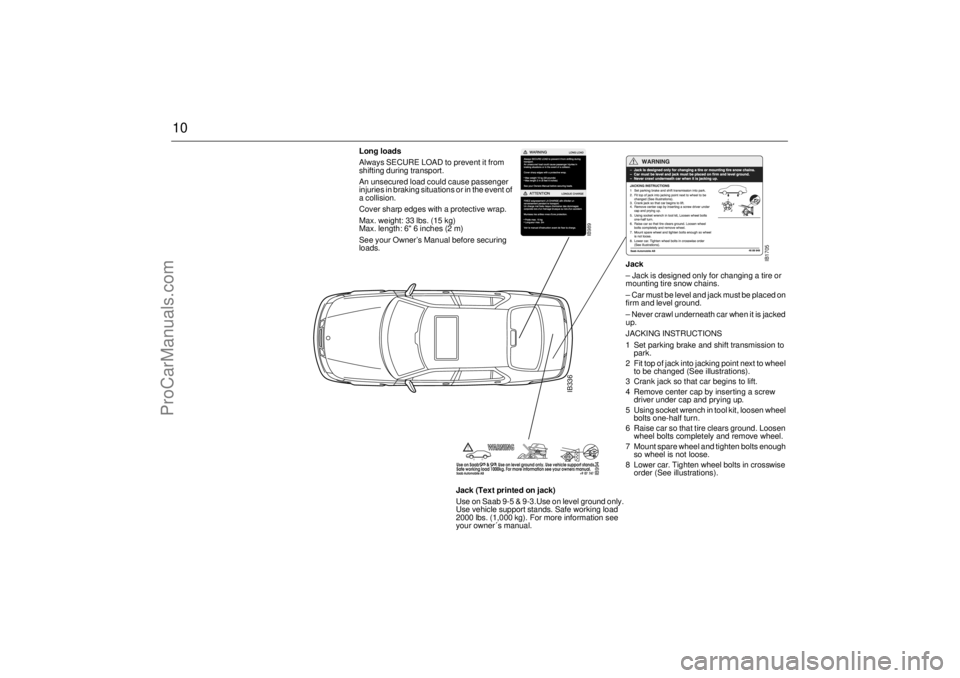
10
IB336
Jack
– Jack is designed only for changing a tire or
mounting tire snow chains.
– Car must be level and jack must be placed on
firm and level ground.
– Never crawl underneath car when it is jacked
up.
JACKING INSTRUCTIONS
1 Set parking brake and shift transmission to
park.
2 Fit top of jack into jacking point next to wheel
to be changed (See illustrations).
3 Crank jack so that car begins to lift.
4 Remove center cap by inserting a screw
driver under cap and prying up.
5 Using socket wrench in tool kit, loosen wheel
bolts one-half turn.
6 Raise car so that tire clears ground. Loosen
wheel bolts completely and remove wheel.
7 Mount spare wheel and tighten bolts enough
so wheel is not loose.
8 Lower car. Tighten wheel bolts in crosswise
order (See illustrations).
IB1705
Jack (Text printed on jack)
Use on Saab 9-5 & 9-3.Use on level ground only.
Use vehicle support stands. Safe working load
2000 lbs. (1,000 kg). For more information see
your owner´s manual.
IB994IB989
Long loads
Always SECURE LOAD to prevent it from
shifting during transport.
An unsecured load could cause passenger
injuries in braking situations or in the event of
a collision.
Cover sharp edges with a protective wrap.
Max. weight: 33 lbs. (15 kg)
Max. length: 6" 6 inches (2 m)
See your Owner’s Manual before securing
loads.
ProCarManuals.com
Page 51 of 272
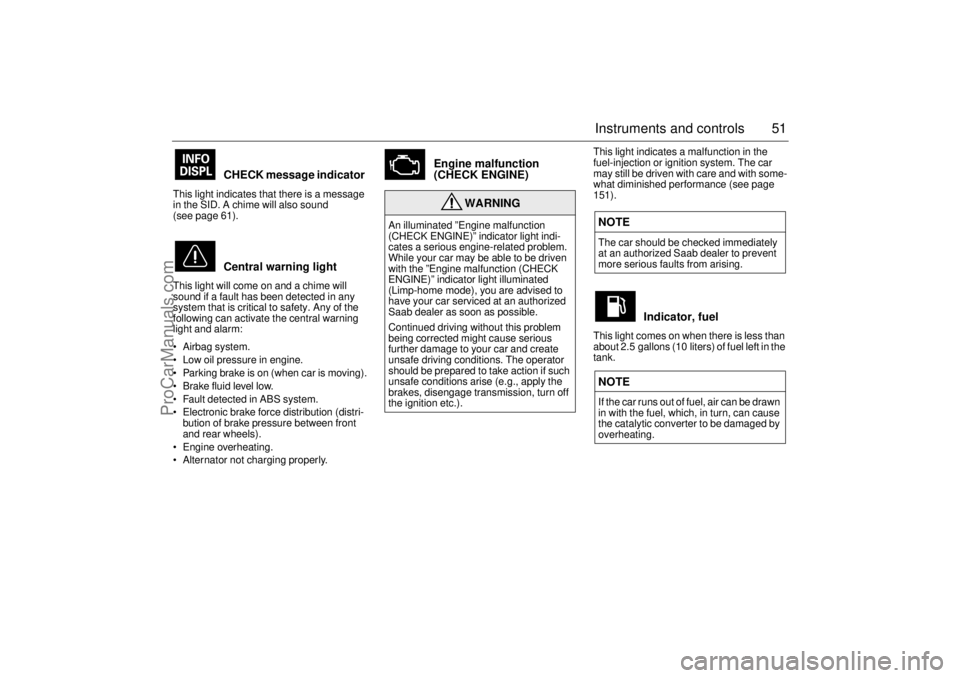
51 Instruments and controls
CHECK message indicator
This light indicates that there is a message
in the SID. A chime will also sound
(see page 61).
Central warning light
This light will come on and a chime will
sound if a fault has been detected in any
system that is critical to safety. Any of the
following can activate the central warning
light and alarm:
Airbag system.
Low oil pressure in engine.
Parking brake is on (when car is moving).
Brake fluid level low.
Fault detected in ABS system.
Electronic brake force distribution (distri-
bution of brake pressure between front
and rear wheels).
Engine overheating.
Alternator not charging properly.
Engine malfunction
(CHECK ENGINE)
This light indicates a malfunction in the
fuel-injection or ignition system. The car
may still be driven with care and with some-
what diminished performance (see page
151).
Indicator, fuel
This light comes on when there is less than
about 2.5 gallons (10 liters) of fuel left in the
tank.
WARNING
An illuminated ”Engine malfunction
(CHECK ENGINE)” indicator light indi-
cates a serious engine-related problem.
While your car may be able to be driven
with the ”Engine malfunction (CHECK
ENGINE)” indicator light illuminated
(Limp-home mode), you are advised to
have your car serviced at an authorized
Saab dealer as soon as possible.
Continued driving without this problem
being corrected might cause serious
further damage to your car and create
unsafe driving conditions. The operator
should be prepared to take action if such
unsafe conditions arise (e.g., apply the
brakes, disengage transmission, turn off
the ignition etc.).
NOTEThe car should be checked immediately
at an authorized Saab dealer to prevent
more serious faults from arising.NOTEIf the car runs out of fuel, air can be drawn
in with the fuel, which, in turn, can cause
the catalytic converter to be damaged by
overheating.
ProCarManuals.com
Page 52 of 272
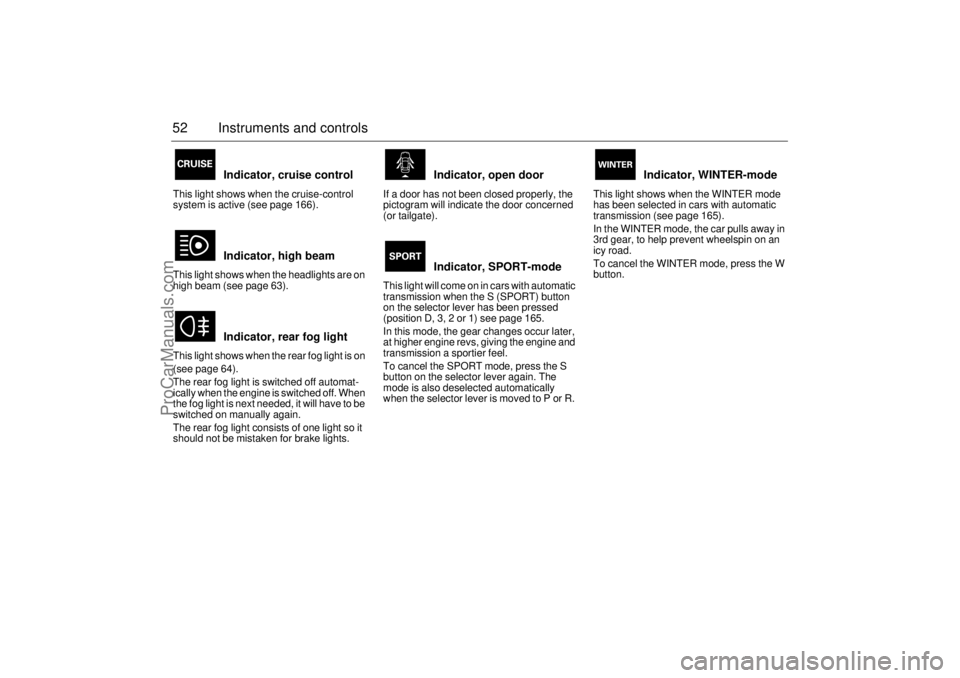
52 Instruments and controls
Indicator, cruise control
This light shows when the cruise-control
system is active (see page 166).
Indicator, high beam
This light shows when the headlights are on
high beam (see page 63).
Indicator, rear fog light
This light shows when the rear fog light is on
(see page 64).
The rear fog light is switched off automat-
ically when the engine is switched off. When
the fog light is next needed, it will have to be
switched on manually again.
The rear fog light consists of one light so it
should not be mistaken for brake lights.
Indicator, open door
If a door has not been closed properly, the
pictogram will indicate the door concerned
(or tailgate).
Indicator, SPORT-mode
This light will come on in cars with automatic
transmission when the S (SPORT) button
on the selector lever has been pressed
(position D, 3, 2 or 1) see page 165.
In this mode, the gear changes occur later,
at higher engine revs, giving the engine and
transmission a sportier feel.
To cancel the SPORT mode, press the S
button on the selector lever again. The
mode is also deselected automatically
when the selector lever is moved to P or R.
Indicator, WINTER-mode
This light shows when the WINTER mode
has been selected in cars with automatic
transmission (see page 165).
In the WINTER mode, the car pulls away in
3rd gear, to help prevent wheelspin on an
icy road.
To cancel the WINTER mode, press the W
button.
ProCarManuals.com
Page 53 of 272
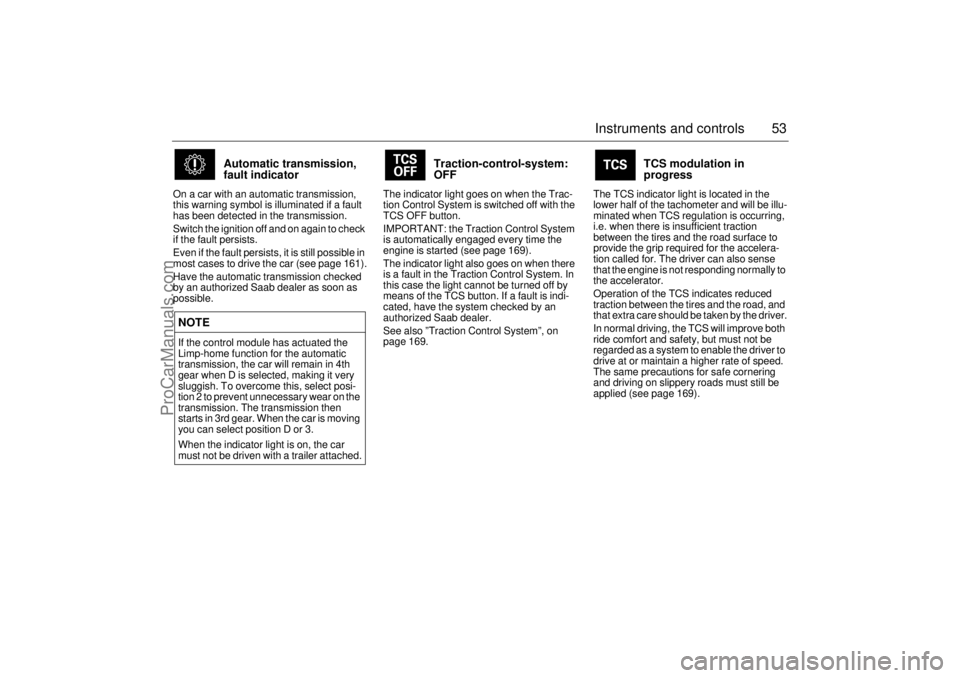
53 Instruments and controls
Automatic transmission,
fault indicator
On a car with an automatic transmission,
this warning symbol is illuminated if a fault
has been detected in the transmission.
Switch the ignition off and on again to check
if the fault persists.
Even if the fault persists, it is still possible in
most cases to drive the car (see page 161).
Have the automatic transmission checked
by an authorized Saab dealer as soon as
possible.
Traction-control-system:
OFF
The indicator light goes on when the Trac-
tion Control System is switched off with the
TCS OFF button.
IMPORTANT: the Traction Control System
is automatically engaged every time the
engine is started (see page 169).
The indicator light also goes on when there
is a fault in the Traction Control System. In
this case the light cannot be turned off by
means of the TCS button. If a fault is indi-
cated, have the system checked by an
authorized Saab dealer.
See also ”Traction Control System”, on
page 169.
TCS modulation in
progress
The TCS indicator light is located in the
lower half of the tachometer and will be illu-
minated when TCS regulation is occurring,
i.e. when there is insufficient traction
between the tires and the road surface to
provide the grip required for the accelera-
tion called for. The driver can also sense
that the engine is not responding normally to
the accelerator.
Operation of the TCS indicates reduced
traction between the tires and the road, and
that extra care should be taken by the driver.
In normal driving, the TCS will improve both
ride comfort and safety, but must not be
regarded as a system to enable the driver to
drive at or maintain a higher rate of speed.
The same precautions for safe cornering
and driving on slippery roads must still be
applied (see page 169).
NOTEIf the control module has actuated the
Limp-home function for the automatic
transmission, the car will remain in 4th
gear when D is selected, making it very
sluggish. To overcome this, select posi-
tion 2 to prevent unnecessary wear on the
transmission. The transmission then
starts in 3rd gear. When the car is moving
you can select position D or 3.
When the indicator light is on, the car
must not be driven with a trailer attached.
ProCarManuals.com
Page 54 of 272
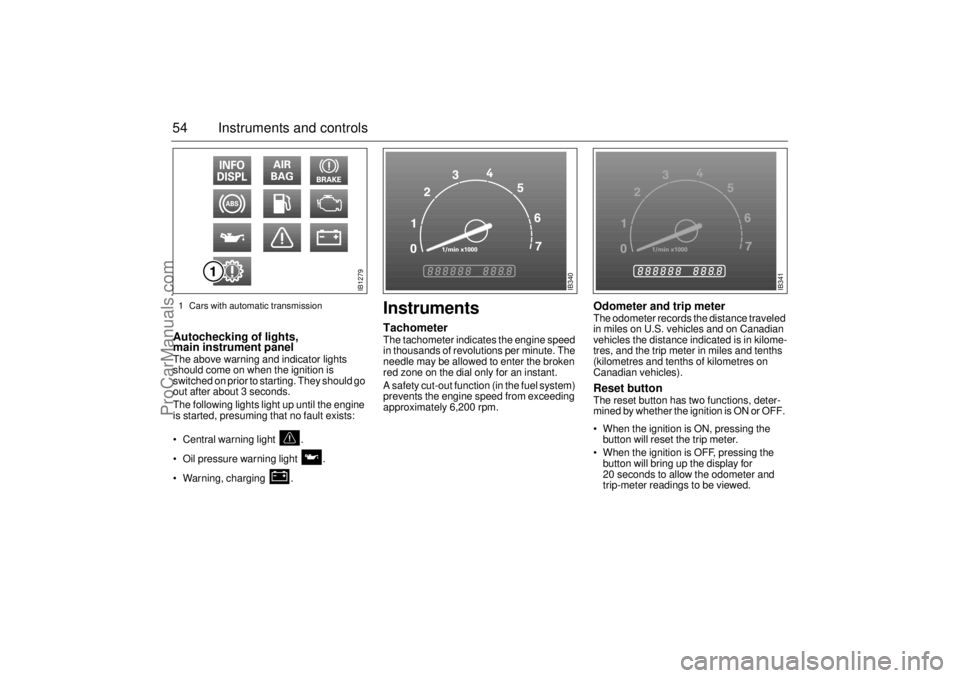
54 Instruments and controlsAutochecking of lights,
main instrument panel The above warning and indicator lights
should come on when the ignition is
switched on prior to starting. They should go
out after about 3 seconds.
The following lights light up until the engine
is started, presuming that no fault exists:
Central warning light .
Oil pressure warning light .
Warning, charging .
InstrumentsTachometerThe tachometer indicates the engine speed
in thousands of revolutions per minute. The
needle may be allowed to enter the broken
red zone on the dial only for an instant.
A safety cut-out function (in the fuel system)
prevents the engine speed from exceeding
approximately 6,200 rpm.
Odometer and trip meter The odometer records the distance traveled
in miles on U.S. vehicles and on Canadian
vehicles the distance indicated is in kilome-
tres, and the trip meter in miles and tenths
(kilometres and tenths of kilometres on
Canadian vehicles). Reset button The reset button has two functions, deter-
mined by whether the ignition is ON or OFF.
When the ignition is ON, pressing the
button will reset the trip meter.
When the ignition is OFF, pressing the
button will bring up the display for
20 seconds to allow the odometer and
trip-meter readings to be viewed.
IB1279
IB340
IB341
1 Cars with automatic transmission
ProCarManuals.com
Page 57 of 272

57 Instruments and controls
Selector lever indication
(Automatic transmission) The position of the selector lever is indi-
cated on the main instrument panel.
Trip computer SID (Saab Information Display (SID) The SID displays CHECK messages and
has eight trip-computer functions (Saab Car
Computer, SCC)
The SID is also used by the Audio System.
SCCSelecting the function
Use the button to scroll through the
following functions:
Use the button to scroll through the
following functions:
WARNING
It is strongly recommended that the SID
settings be changed only when the car is
stationary. The driver’s attention can
otherwise easily be distracted from the
road.
DIST Distance to destination / Trip
meter.
ARRIV Estimated time of arrival.
ALARM Alarm function.
SPD W Speed warning (chime).
TEMP Outdoor temperature and Date.
D.T.E. Estimated range (distance to
empty fuel tank).
FUEL∅ Average fuel consumption
since function last reset.
SPD∅ Average speed since function
last reset.
NIGHT PANEL
CLEAR
SET
IB346
IB1280
ProCarManuals.com
Page 61 of 272

61 Instruments and controls
CHECK messages When the engine is started, CHECKING will
appear on the display for about four sec-
onds, while the SID checks are being per-
formed.
When a CHECK message is generated
while the car is being driven, a chime will
sound, INFO DISPL will illuminate on on the
main instrument panel, and the message
will appear on the SID. The number of mes-
sages that can be displayed by the SID
varies with the specification of the car.
If more than one CHECK message has
been generated, the
+ symbol will appear to
the left of the text on the display. The mes-
sages appear in order of priority.
If a new fault occurs while another message
is being displayed, the message relating to
the new one will appear for 10 seconds,
after which the display will return to the ear-
lier one.
Press CLEAR once to acknowledge a mes-
sage, whereupon it will be cleared from the
display. It will not be displayed again before
the ignition has been switched off and then
on again. The following messages may be displayed:
1 This message will be displayed approxi-
mately 600 miles (1,000 km) before the next
scheduled service is due, or when 365 days
have elapsed since the last service. The
message should be cleared at the time of that
service (see the Saab Warranties & Service
Record Booklet).
This message can also be deleted by first
briefly pressing the CLEAR button, then
depressing it a second time for at least eight
seconds until ”SERVICE” appears on the dis-
play and a chime sounds. The message can
only be deleted when it is shown on the SID.
Night panelTo improve night-driving conditions inside
the car, the Night Panel mode can be
selected. In this mode, the amount of infor-
mation displayed is reduced, and only the
most important instruments and displays
will be illuminated.
When the Night Panel button is pressed,
only the speedometer will be illuminated (up
to the 87-mph or 140-km/h graduation), all
the other instruments illumination being
extinguished and their needles moved to
zero. Both the SID and the ACC displays will
be extinguished and the backlighting for
switches and other controls will be dimmed.
Note: All indicator and warning lights,
together with the display of CHECK mes-
sages, will operate as normal, except ”Out-
door temperature (Frost warning)”, see
page 58. Message See
page
FRONT LIGHT FAILURE 205
REAR LIGHT FAILURE 208
FOG LIGHT FAILURE 209
BRAKE LIGHT FAILURE 208
WASHER FLUID LEVEL LOW 204
FILL COOLANT FLUID 196
REPLACE KEY BATTERY 37
KEY NOT ACCEPTED 45
SERVICE THEFT ALARM 45
TRANSMISSION OVERHEATING 162
TIGHTEN FUEL FILLER CAP 154
TIME FOR SERVICE
1)
242
ProCarManuals.com